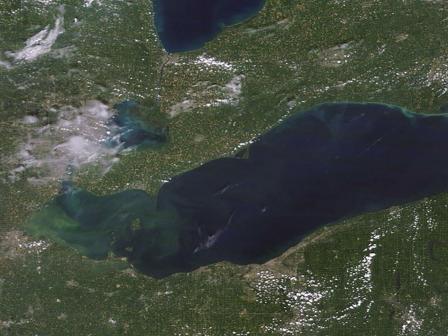Lake Erie
 About one-third of the total population of the Great Lakes basin is in the Lake Erie watershed. Approximately twelve million people live in the watershed, including seventeen metropolitan areas with more than 50,000 residents. The lake provides drinking water for about eleven million of these inhabitants.
About one-third of the total population of the Great Lakes basin is in the Lake Erie watershed. Approximately twelve million people live in the watershed, including seventeen metropolitan areas with more than 50,000 residents. The lake provides drinking water for about eleven million of these inhabitants.
On this page:
About Lake Erie
During the 1960s water quality issues in the Great Lakes became a concern and Lake Erie was perceived to be "dying". By the late 1960s, Canadian and American regulatory agencies were in agreement that limiting phosphorus loads was the key to controlling excessive algal growth and that a coordinated lakewide approach was necessary to deal with the phosphorus issue. Open lake phosphorus concentrations declined due to the joint efforts made. These controls represented an unprecedented success in producing environmental results through international cooperation.
- the smallest by volume
- the shallowest
- warms rapidly in the spring and summer
- frequently freezes over in winter
- average depth is only about 62 ft. (19m)
- the western basin (about 20% of the lake), is very shallow with an average depth of 24 ft. (7.4m)
- retention time = 2.6 years (a measure based on the volume of water in the lake and the mean rate of outflow)
- most of the land area around the lake is urban or agricultural
- 17 metropolitan areas with populations over 50,000 within the Lake Erie basin
- significant effects from urban and agricultural runoff
from Lake Erie Binational Nutrient Management Strategy, 2011
The Scientific Studies of the Physical Processes and Forces Affecting Lake Erie and Lake St. Clair
- The western basin is very shallow, with an average depth of 7.4 metres (24 ft) and a maximum depth of 19 metres (62 ft). It is the most turbid region of the lake as most of the lake bottom is covered with fine sediment particles that are easily disturbed by wind and wave action.
- The central basin is quite uniform in depth, with an average depth of 18.3 metres (60 ft) and a maximum depth of 25 metres (82 ft).
- The eastern basin is the deepest of the three basins, with an average depth of 24 metres (80 ft) and a maximum depth of 64 metres (210 ft).
The central and eastern basins change in the temperature at different depths every year.
Stratification refers to the layering that occurs, particularly in the warmer months, where a warmer, less dense layer of water (the epilimnion) overlies a colder denser layer (the hypolimnion). Stratification can occur in the western basin but does not last very long. Stratification impacts the internal dynamics of the lake physically, biologically and chemically, and this in turn affects the amount of dissolved oxygen present at the bottom of the lake.
NOAA Image Measurement of Depth of Water in Lake Erie and Lake St. Clair Image
Environmental Issues
- Excessive algal growth in Lake Erie threatens the ecosystem and human health of a waterbody that provides drinking water for 12 million people in the U.S. and Canada.
- Algae can persist for weeks during summer by blooms carried by winds and currents eastward through the lake.
- Recent years have seen record-setting algal blooms and associated “dead zones” – oxygen depleted areas created when algae die and decompose set records in recent years.
- These events negatively impact the lake’s critical $12.9 billion tourism industry and world class fishery.
The Lake Erie watershed, the most populated of all Great Lakes basins, is very diverse. It is largely agricultural, intensively industrialized, and highly urbanized. About one third of the total population of the Great Lakes basin resides within the Lake Erie watershed.
Of all the Great Lakes, Lake Erie is exposed to the greatest stress from urbanization, industrialization and agriculture. Lake Erie surpasses all the other Great Lakes in the amount of effluent received from sewage treatment plants and is also most subjected to sediment loading due to the nature of the underlying geology and land use. Exposed agricultural and urban lands, particularly in southwest Ontario and northwest Ohio, contribute immense sediment loads to the lake.
Lake Erie is the smallest of the Great Lakes by volume and also the shallowest. It warms quickly in the spring and summer and cools quickly in the fall. The shallowness of the basin and the warmer temperatures make it the most biologically productive of the Great Lakes.
- Eighty percent of Lake Erie’s total inflow of water comes through the Detroit River
- Eleven percent is from precipitation (rain and snow)
- The remaining nine percent comes from the other tributaries
What EPA is Doing
- Lake Erie LAMPS and Associated Reports
- Lake Erie Great Lakes Areas of Concern (AOCs)
- Ashtabula River AOC - Ohio
- Black River AOC - Ohio
- Buffalo River AOC - New York
- Clinton River AOC - Michigan
- Cuyahoga River AOC - Ohio
- Detroit River AOC - Michigan
- Maumee River AOC - Ohio
- Presque Isle Bay AOC - Pennsylvania - DELISTED
- River Raisin AOC - Michigan
- Rouge River AOC - Michigan
- St. Clair River AOC - Michigan
- Wheatley Harbour AOC - Canada EXIT- DELISTED
- Great Lakes Restoration Initiative Grants
- Cleveland Metropolitan Park District ($316,830) for invasive species control.
- The Nature Conservancy ($650,000) for invasive species control.
- IPM Institute of North America ($408,150) for agricultural watershed management implementation.
- Toledo Metropolitan Area Council of Governments ($497,258) for agricultural watershed management implementation.
- Western Reserve Land Conservancy ($500,000) for agricultural watershed management implementation.
- Winrock International Institute for Agricultural Development ($500,000) for agricultural watershed management implementation.
